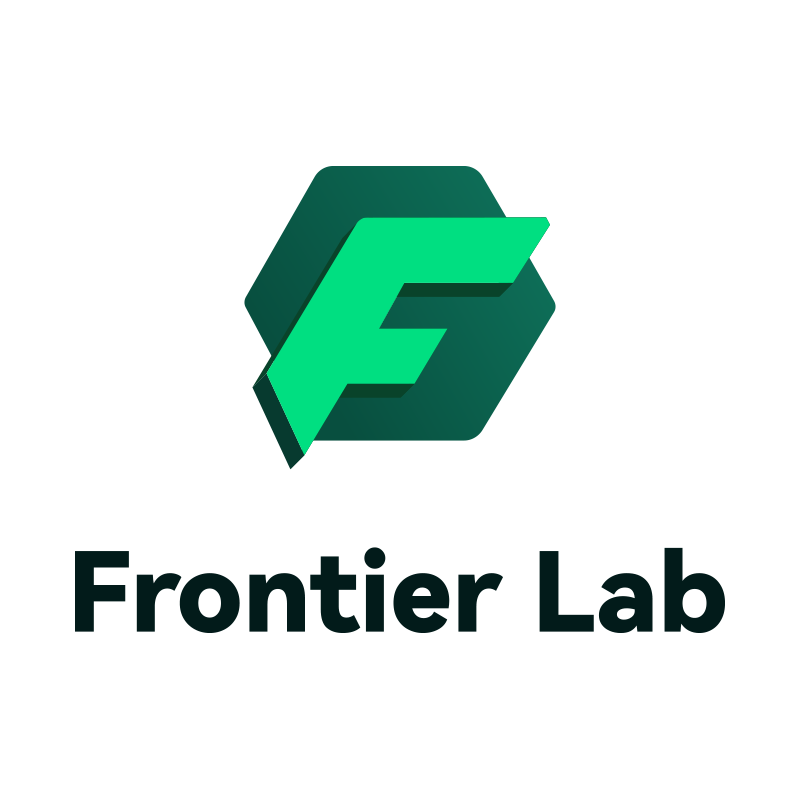introduction
Phala Network was founded in 2018. At the beginning of the project, Phala Network positioned itself in the privacy computing track, combining the smart contract execution environment with TEE to achieve safe and reliable smart contract execution. At the same time, Phala Network also provides a complete privacy protection mechanism to ensure that users data is in their own hands. In 2023, because the US stock market led the AI-based trend in the market, Phala Network followed the AI trend at the time and became an artificial intelligence agent. It also followed the concept of modularization and built itself into the execution layer of artificial intelligence.
Basic information of the project
basic information
Website: https://phala.network/
Twitter: https://twitter.com/PhalaNetwork, 122,000 followers
TG: https://t.me/phalanetwork
Discord: https://discord.com/invite/phala-network
Whitepaper: https://docs.phala.network/
Launch time: The token will be launched in 2020
project team
core team
Marvin Tong: Founder CEO. Graduated from Communication University of China with a masters degree. After graduation, he has been working as a product manager in companies such as Tencent and Didi.
Hang Yin: Co-founder Chief Technology Developer. Graduated from Fudan University, China. Previously, he was an expert in Google search ML related fields, one of the Chinese Polkadot ambassadors, and the founder of Bitcoin Gold.
Zhe Wang: Co-founder COO. Graduated from Huazhong University of Science and Technology with a masters degree, he is an expert in Huazhong University of Science and Technologys computer hardware laboratory, and CTO CEO of Bitcoin Gold, Xiaohei Technology, and Haha Retail.
Jun Jiang: Co-founder CTO. Former webmaster of RubyChina. Former CTO of KnewOne and former software architect of DJI.
Advisory Team
Shun Fan Zhou: One of the authors of the Phala Network white paper, he is a Ph.D. in System Software and Security Laboratory of Fuzhou University. He has published research on attack transactions and defense methods in the Dafang ecosystem at the top international security conference USENIX Security, and has collaborated in publishing papers at many top international security conferences.
Sandro Gorduladze: Angel Investor and Partner at HASH CIB. Sandro set up the research department at HASH, which has become famous for its in-depth reports. Prior to joining HASH, Sandro worked at PwC Russia, providing tax consulting to companies in the TMT industry.
Konstantin Shamruk: PhD in Economics from the University of Toulouse, France. He led the theoretical analysis of Phala Network’s economic design.
Jonas Gehrlein: Research Scientist at Web3 Foundation. He is responsible for researching economic issues in the Polkadot ecosystem at Web3 Foundation. Prior to joining W3F, Jonas received his PhD in Behavioral and Experimental Economics from the University of Bern, where he studied human behavior in markets and organizations. Prior to that, he received his Masters degree in Quantitative Economics from the University of Konstanz.
Zo Meckbach: Senior Polkadot Ambassador, researcher and advocate for Web3 and network security. She is currently the COO of MH-IT Service GmbH and worked in application analytics at Google before joining MH-IT.
Financing:
Phala Network has raised about $10 million in a round of funding.
Seed round
In July 2020, Candaq Group, IOSG Ventures, SNZ, Incuba Alpha Group, nfiChain, Exoplanet Capital and Blue Mountain Labs invested in this round with an amount of US$10 million.
Development Strength
Phala Network was established in 2018 by founder Marvin Tong. The key events in the development of the project are shown in the table:
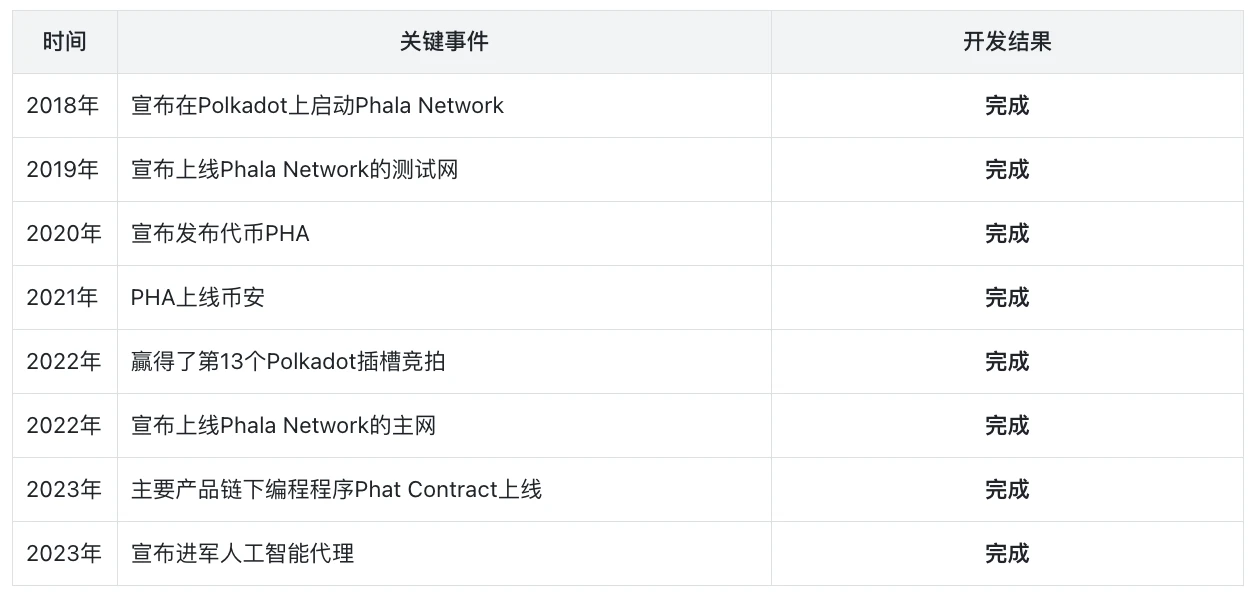
Judging from Phala Networks project development roadmap, the Phala Network team was able to complete the projects scheduled plan on time at each key time point of the project. It can be seen that the technical development team led by Marvin Tong and Hang Yin is very strong. Although Phala Network has a broader development prospect after entering the AI track, the technical challenges it faces will become greater, and the requirements for the technical development team will become higher.
Technical Features
Phala Network is a privacy computing infrastructure based on the Polkadot ecosystem, which aims to achieve data confidentiality and privacy protection through trusted execution environment (TEE) technology, cloud computing services and cross-chain data confidentiality layer. At the same time, Phala Network uses artificial intelligence coprocessors to provide a secure and verifiable computing solution for integrating encryption and artificial intelligence at the application layer.
It can be simply understood that Phala Network has added an AI coprocessor on top of the original privacy computing infrastructure, so that AI proxy contracts can be deployed on Phala Network, and Phala Network has become the execution layer of Web3 AI. Phala Network has protected its privacy through TEE technology. Now, top-level LLMs can be accessed through Phala Networks AI proxy contract, and control comes from the smart contract written on the chain.
Schematic diagram of Phala Networks AI Agent (Image from Phala Network white paper)
Before adding the AI proxy contract, the main technical feature of Phala Network was to achieve data confidentiality and privacy protection through a variety of technical means. First, Phala Network uses hardware privacy computing technology, especially the trusted execution environment (TEE), to ensure the confidentiality and integrity of data during the calculation process. All calculations running in the TEE guarantee the correctness of program execution and the security of data. At the same time, Phala Network also combines zero-knowledge proof technology, which can realize private transactions so that the data of smart contracts does not have to be made public, thereby protecting the privacy of users. In this way, Phala Network is able to provide general and easy-to-use confidential smart contracts that support zero-trust cloud services.
The key points are the Trusted Execution Environment (TEE) and the multi-layer key rotation system.
Trusted Execution Environment (TEE): A Trusted Execution Environment (TEE) is a privacy-focused technology that isolates the code execution and operation of a node from the main operating system of a computer processor. Phala Network uses Intels Software Guard Extensions (SGX) for TEE processing. This system ensures that even individuals with physical access, such as the operator of the Phala Network or a malicious third party, cannot view the state of the node or manipulate the data processed by the node. Typically, Trusted Execution Environments are used in place of Zero-Knowledge Proofs (ZKPs). In Phala Network, TEE is used not only to protect the confidentiality and integrity of data, but also to support complex computing tasks. For example, by shifting the execution of smart contracts to off-chain security workers supported by TEEs, Phala Network is able to fully utilize the computing power of a single worker without worrying about the risk of data leakage or tampering.
Multi-layer key rotation system: Phala Network has a group of special worker nodes called gatekeepers whose main task is to ensure the security of computing. In Phala Network, Worker nodes do not have the authority to exit the network at any time, so tasks need to be deployed to redundant Worker nodes with the same key to ensure access to encrypted inputs, outputs, and program states. The gatekeeper node is responsible for managing encryption keys and dynamically assigning secrets to worker nodes, thereby ensuring the security and integrity of data. At the same time, Phala Network adopts a comprehensive key rotation mechanism to ensure the privacy of its contracts and the overall security of the system. This process regularly updates the master key according to the election rules. In the new cycle, the new gatekeeper is elected and a new master key is generated through a secure key exchange protocol. The new key is used to re-encrypt the gatekeeper state, which is then distributed and confirmed among the new gatekeepers. During this transition period, communication between miners and gatekeepers is temporarily interrupted to maintain consistency and security. Communication will only resume after the key rotation is completed, with a delay of two on-chain confirmations. In addition to rotating the master key, Phala Network also regularly updates cluster keys and contract keys to enhance security.
After Phala Network added the artificial intelligence proxy contract, Phala Networks main business has shifted from the original privacy computing infrastructure to the execution layer of Web3 artificial intelligence. Its original privacy computing infrastructure has become the basis of the current Web3 artificial intelligence execution layer, and the existing artificial intelligence proxy contract operates on the original privacy computing basis.
AI Agent Contracts: AI Agent Contracts are a tool for users to build smart contracts that can control AI agents that can run on or off the blockchain. The code for these AI agents is written in TypeScript/JavaScript and executed in Phala Networks nodes, and they are able to aggregate data from external APIs and plug in custom AI agents. AI agents utilize Phala Networks trustless cloud computing infrastructure for off-chain confidentiality procedures. On a technical level, AI Agent Contracts run on TEEs within worker nodes, which are managed by Phala Network. A subset of gatekeeper worker nodes is responsible for managing keys to ensure network security. These contracts provide developers with powerful tools to enable them to use AI agents to perform various tasks, and they can also be guaranteed when handling sensitive data due to the security and privacy of their operating environment. The development of AI Agent Contracts has opened up new possibilities for the application of blockchain technology, and also brought more room for innovation for developers.
pRuntime: The worker node hosts the AI proxy contract in the nodes TEE, which protects the code integrity and privacy of the workload, ensuring that the contract is not subject to malicious attacks and tampering during execution, while providing powerful computing power for the network. pRuntime (Phala Runtime) is a program running inside the TEE. It is the core component of the Phala Networks worker node. pRuntime is responsible for receiving and running computing tasks from the blockchain to ensure the tamper-proof and security of the computing.
In summary, Phala Network introduces AI agent contracts, making AI agents as simple to run as smart contracts, and AI agents are managed by smart contracts, so that AI agents can be managed and access controlled at any time. In addition, AI agents can freely call each other to form complex applications, and all these operations are run in TEE, ensuring the integrity and privacy of the code. This allows Phala Network to fully utilize the advantages of the previous privacy computing infrastructure when transforming into the execution layer of Web3 AI.
Innovation compared with similar projects
After Phala Network introduced the artificial intelligence coprocessor, although the underlying operating logic of the Phala Network project has not changed, the main narrative of the project has shifted from the original privacy computing infrastructure track to a sub-track in the AI track: the algorithm track, and its competitors have also become Morpheus, QnA3.AI, Fetch.AI, SingularityNet, ChainGPT and other projects.
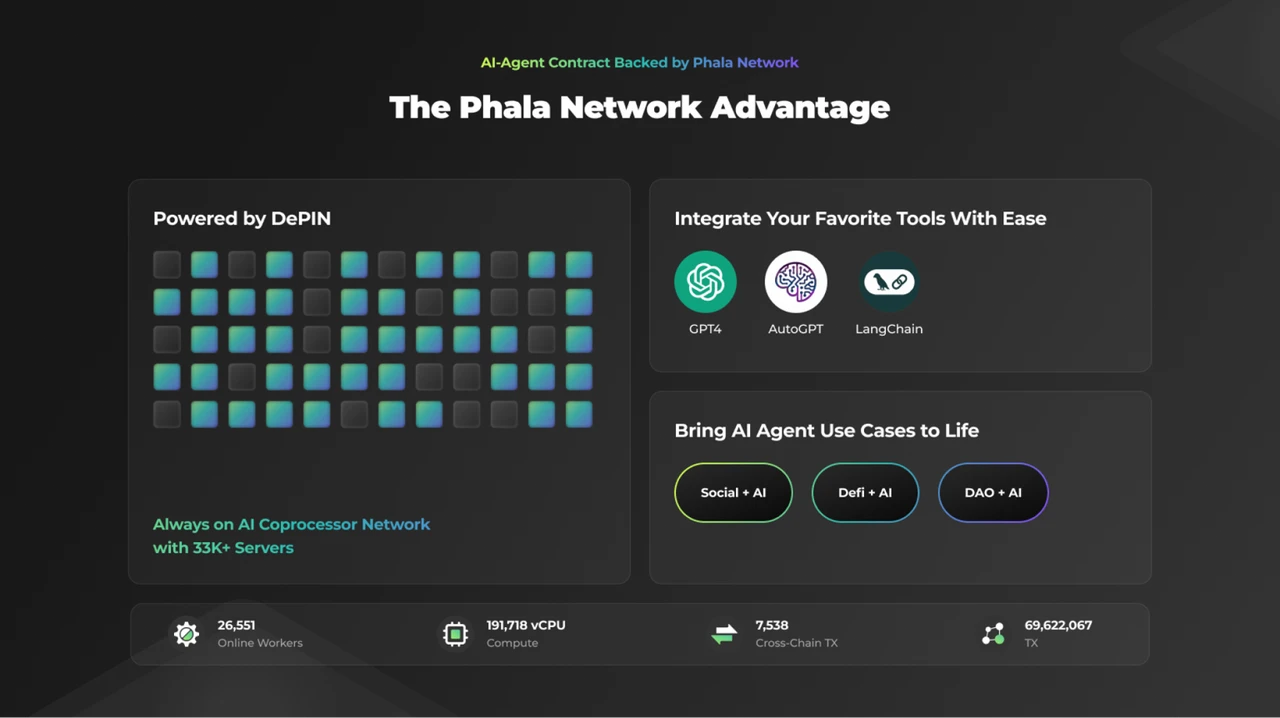
Advantages of Phala Network (Image from Phala Network White Paper)
Super strong privacy: Phala Network was engaged in privacy computing business before it transformed into AI track, so it has inherent privacy advantages. Phala Network uses hardware privacy computing technology, especially TEE, to ensure the confidentiality and integrity of data during the calculation process. All calculations in TEE guarantee the correctness of program execution and the security of data. At the same time, it also combines zero-knowledge proof technology to realize private transactions and protect smart contract data from being disclosed, thereby maintaining user privacy. In this way, Phala Network provides users with safe and reliable privacy computing solutions and provides solid technical support for privacy protection of blockchain applications.
Powerful functions: Phala Network introduced the AI agent contract, which gave it an absolute advantage in the AI agent track. The AI agent contract makes the AI agent run as simply as a smart contract, and enables the AI agent to be managed by the smart contract, so that the AI agent can be managed and access controlled at any time, and enables the EVM smart contract to expand its functions outside the chain, which greatly improves the deployment and work efficiency of the AI agent. Thus, an AI agent centered on smart contracts is achieved.
Rich integration: Phala Network uses artificial intelligence agent contracts to aggregate data from external APIs and insert custom AI Agents. It also eliminates the learning difficulties of accessing decentralized applications. This allows for large-scale and easy access to excellent external AI tools and projects, such as OpenAI, LangChain, GPT 4, etc.
Wider applications: Due to the use of AI agent contracts, the deployment of Phala Networks AI agents is very simple and can be deployed in a wide range of areas. Users can link their own AI agents to Social, Defi or Dao according to their preferences and needs to improve their efficiency in work and life.
In summary, Phala Network, with its superior performance, has made the deployment and use of artificial intelligence agents a very simple thing. While solving the ease of operation and deployment for users, it also solves the privacy concerns of some users, giving Phala Network a huge advantage in the competition in the AI track.
Project Model
Business Model
Since Phala Networks current basic narrative has shifted from privacy computing to the AI track, the Phala Network economic model consists of four roles: miners, staking users, users using artificial intelligence proxy contracts, and users using privacy computing.
Miners: Phala Networks miners are the providers of network computing power. Miners provide the CPU computing power of their computers that they can control to Phala Network. They are the only people responsible for actual calculations in Phala Network. They are the foundation of the existence of the entire network. The more computing power they provide, the more generous rewards they can get.
Staking users: Because the mining design of Phala Network requires miners to provide more than just computing power, in order to prevent mining from working maliciously, a certain amount of PHA tokens must be staked as a deposit. However, some miners are only willing to provide computing power and do not want to provide additional tokens for staking, so staking users can be divided into two types: Stakepool and Vault. Among them, Stakepool is only a miner who provides computing power and is willing to provide staked tokens or directly provides the PHA tokens held by itself to Stakepool. If the coin holder does not want to stake the tokens directly to a Stakepool, he can also put the tokens into Vault, and Vault will stake them according to the performance of each Stakepool.
Users of artificial intelligence proxy contracts: Users of artificial intelligence proxy contracts are now the main users of the Phala Network project. When they run artificial intelligence proxy contracts on the Phala Network, they need to pay fees to the Phala Network. The fees are paid in the form of PHA tokens, which is also one of the main sources of income for the Phala Network.
Users using privacy computing: Phala Network will still attract some users who have real needs for privacy computing with its excellent privacy computing business. The fees paid by users using privacy computing are also one of the main sources of income for miners and Phala Network.
From the above analysis, we can see that Phala Networks revenue is:
Usage fees paid by users of AI agent contracts
Usage fees paid by users who use privacy computing
Token Model
According to the white paper: the total amount of PHA is 1 billion, the current circulation is 738.3 million, and the circulation rate is 73.83%. The overall token distribution is as follows:
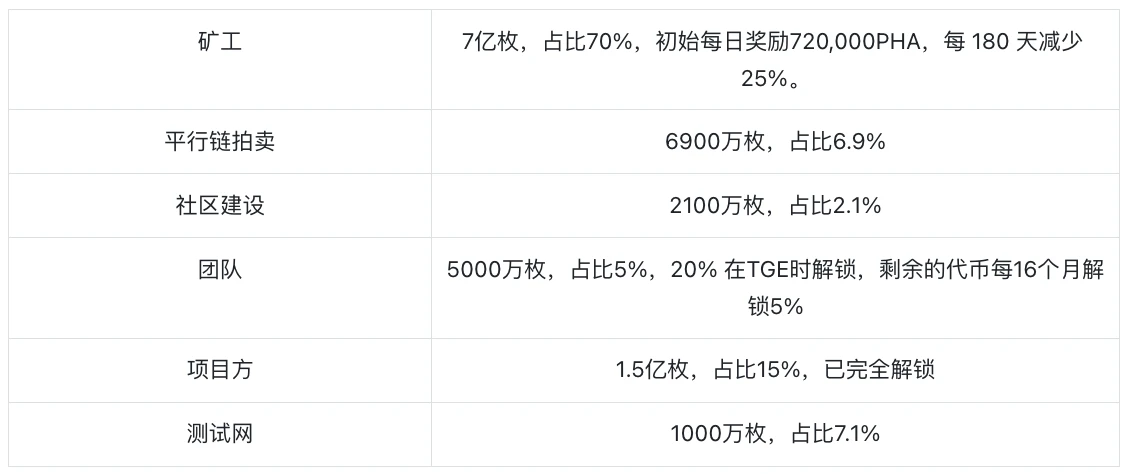
Token empowerment:
According to the white paper, the uses of PHA in Phala Network are as follows:
Miner Rewards: Miners in the network receive PHA tokens for mining new blocks, requiring them to provide computing power.
Usage fees: Users who use AI agent contracts and privacy computing pay fees with PHA tokens.
Participate in governance: After staking PHA tokens, you can participate in the governance of PhalaDAO.
Participate in staking: Phala Network’s mining design requires miners to not only provide computing power, but also to stake a certain amount of PHA tokens as a deposit to prevent miners from working maliciously.
Determination of the value of PHA
According to the white paper, in the Phala Network network, the empowerment of PHA tokens is quite standard, and a pledge mechanism is added, which in disguise increases the key point of locking PHA tokens to increase the value of the project. Now the circulation rate of PHA tokens has reached 73.83%. From the perspective of circulation rate, the circulation rate of PHA is slightly higher now, but it is still at a stage where nearly one-third of the tokens have not been developed. Therefore, in the future development of the project, more value increase for PHA tokens comes from the value of the Phala Network project itself, that is, the degree of use of artificial intelligence proxy contracts by market users. If the use is high, then with the increase in token prices, the income of miners will also increase, which will lead to more miners entering mining to lock more tokens to reduce the circulation rate of tokens, so as to form a positive flywheel. However, there is no scenario of centralized destruction or regular destruction of PHA tokens, which is a shortcoming in its token economics. If the business of Phala Network does not develop well, the price of its tokens will not rise accordingly.
Token Price Performance
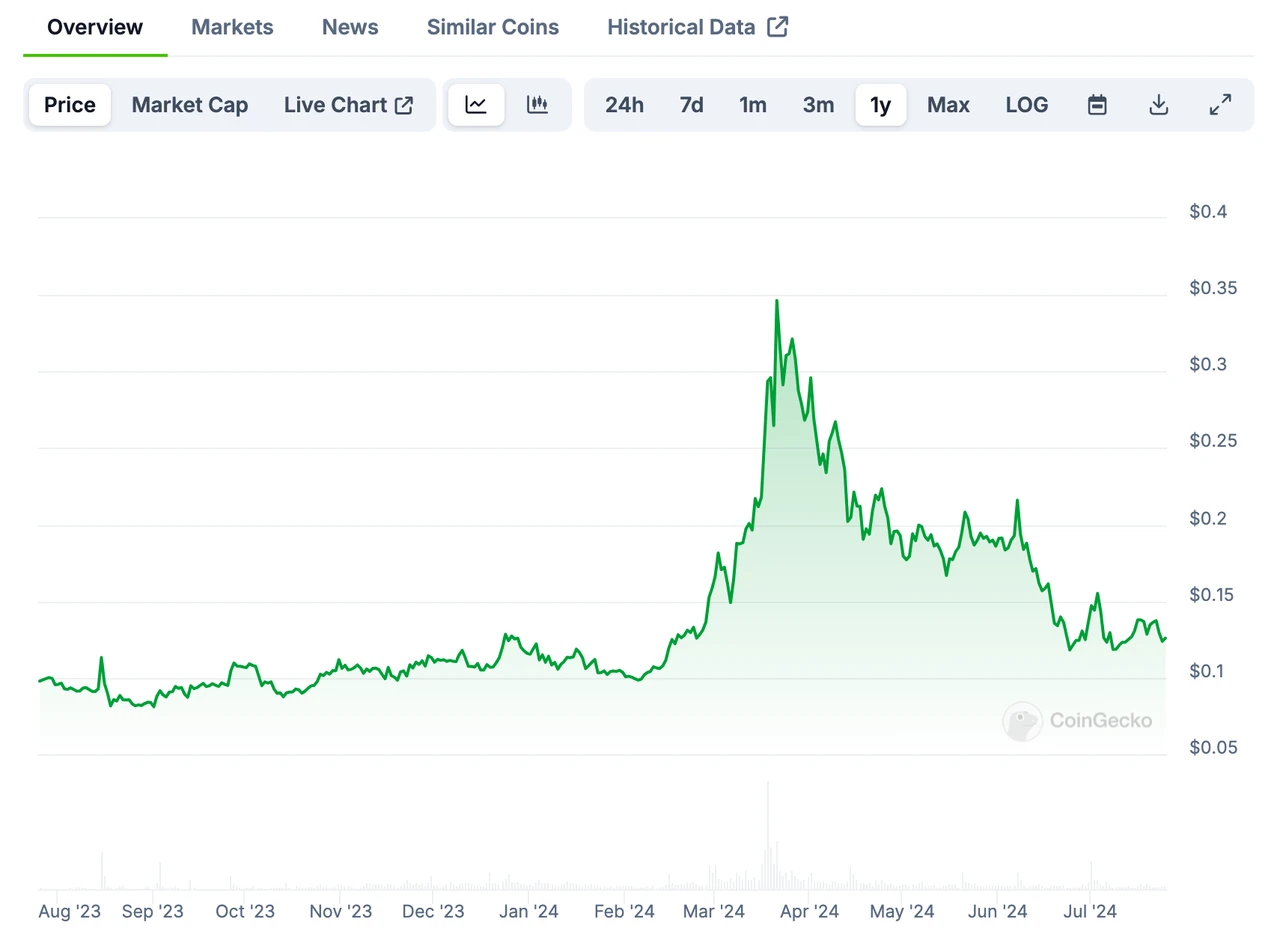
PHA price trend (data source: https://www.coingecko.com/en/coins/phala-network)
According to Coingecko statistics, the price of PHA has risen more than 4 times since July 2023 (the lowest point is US$0.0816 and the highest point is US$0.3465). The main trading venues are first-tier exchanges such as Binance, OKX, and HTX. The increase this year is mainly due to the dividends of the development of the AI track.
Market Cap
The current price of PHA is $0.126, the current circulation is 738,334,838 pieces, and the market value is: $93.43 million.
FDV
The current price of PHA is $0.126, the total circulation is 1 billion, and the market value is: $126.54 million.
Average daily trading volume:
PHA’s average daily trading volume is around US$5.66 million.
PHAs daily trading volume is $5.66 million, and its market capitalization is approximately $126.54 million. Although the turnover rate is only 4.47%, which is on the low side, it is more because the current market environment is relatively sluggish. Recently, affected by the Mtgox incident, most users are in a wait-and-see state.
Top 10 Token Holding Addresses
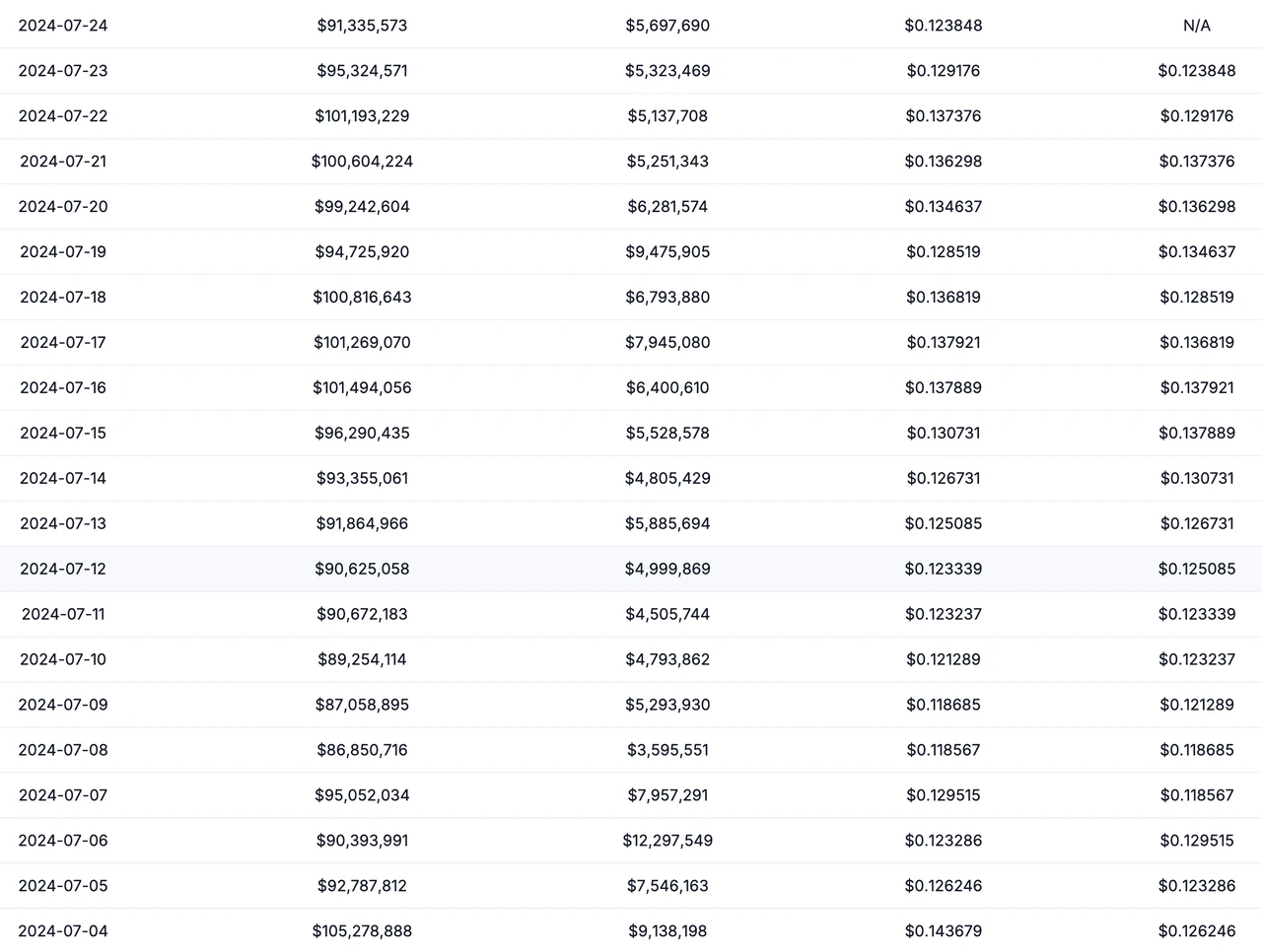
PHA daily transaction volume (data source: https://www.coingecko.com/en/coins/phala-network/historical_data)
As can be seen from the figure, the top ten PHA holding addresses account for a total of 92.19%.
PHA coin holders
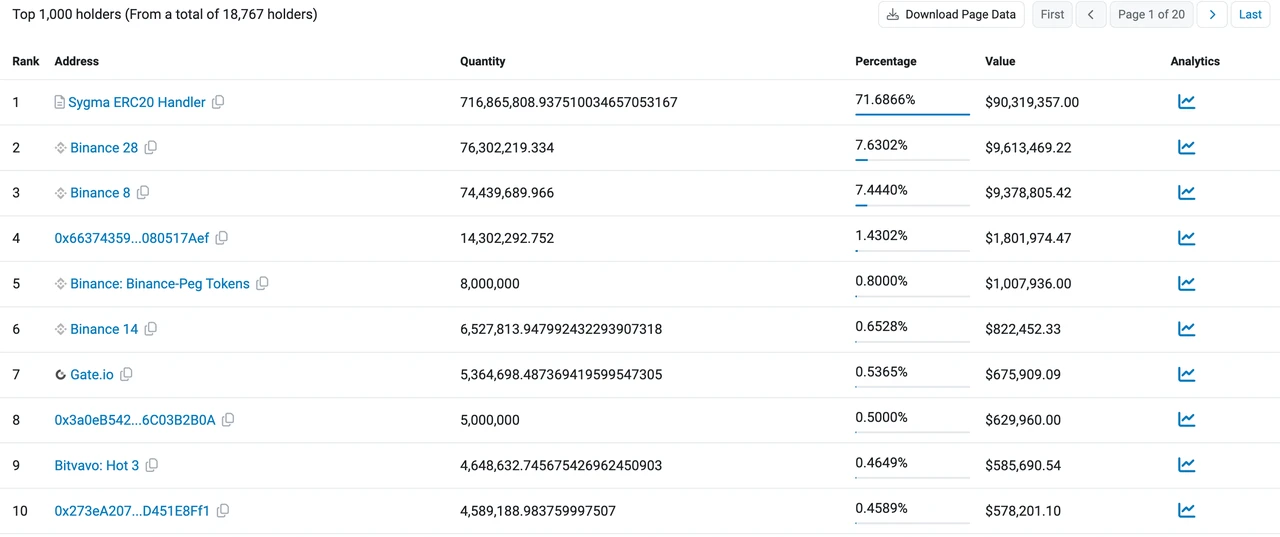
Top ten PHA holding addresses (data source: https://etherscan.io/token/0x6c5bA91642F10282b576d91922Ae6448C9d52f4E#balances)
It can be seen that the number of people holding PHA tokens has been steadily increasing in the past year.
Daily active accounts
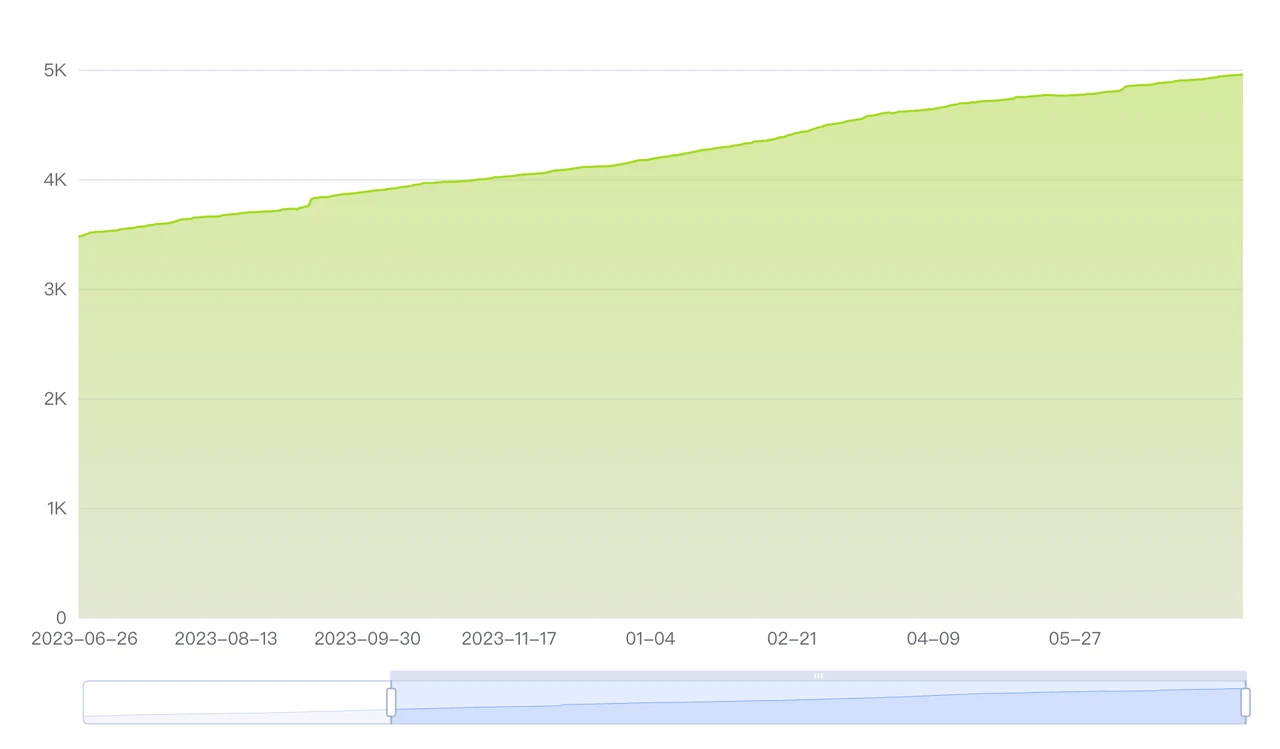
Number of PHA holders (data source: https://phala.subscan.io/tools/charts?type=holder)
It can be seen that Phala Network’s daily active accounts have continued to increase over the past year.
Pledge Status
From the figure, we can see that the circulation volume of PHA should be 847.27 million, but the actual circulation volume is 738.33 million. It can be concluded that the actual pledged volume should be 108.94 million.
Project Risks
Although Phala Network changed the track of its project to the AI track after launching the artificial intelligence proxy contract, which is conducive to the development of its project and the growth of the currency price, the technical challenges it faces have also increased exponentially. In particular, Phala Network has adopted a relatively complex artificial intelligence proxy contract based on privacy computing, and will continue to connect new AI Agents in the future, which has also posed a considerable challenge to its technical team. Therefore, there will inevitably be some system problems in the future. This depends on the problem-solving ability of the Phala Network team and whether the Phala Networks artificial intelligence proxy contract is as powerful as advertised. Therefore, there are many uncertain factors at present.
Summarize
Phala Network introduces AI agent contracts, making AI agents as easy to run as smart contracts and managed by smart contracts, thus achieving real-time management and access control of AI agents. Different AI agents can freely call each other to build complex applications, and all operations are performed in a trusted execution environment (TEE) to ensure the integrity and privacy of the code. This allows Phala Network to take full advantage of the previous privacy computing infrastructure and transform it into a Web3 AI execution layer. This innovation provides a new solution for the security and privacy protection of AI applications, and provides strong support for the integration of smart contracts and blockchain technology.
After launching the AI agent contract, Phala Network positioned the project in the AI track, which is beneficial to the development of the project and the growth of the coin price. However, the accompanying technical challenges have also increased exponentially. In particular, Phala Network uses a complex AI agent contract based on privacy computing, and will continue to connect new AI Agents in the future, which poses a huge challenge to the technical team.
In summary, the Phala Network project itself has a certain advantage in the privacy computing infrastructure track through the introduction of the trusted execution environment (TEE). And now with the support of artificial intelligence proxy contracts, if it can proceed as planned according to the subsequent project plan, then Phala Network will also have a certain advantage in the AI track.
References
Understanding Phala Network: A Comprehensive Overview
Can Phala Network, the DePin project in the Polkadot ecosystem, break through the siege?

